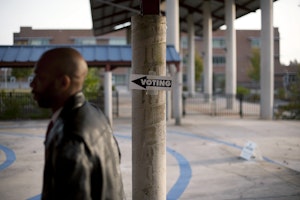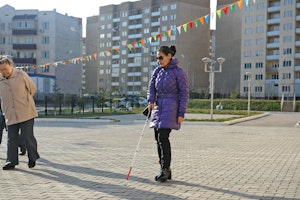The Selma March and the Challenges Ahead
By Allison Brown
The moment may have passed, but the memories are still fresh. The 50th anniversary march in Selma, Alabama, was a reminder both of how far we have come as a nation—and how far we have yet to travel.
I was in the crowd last weekend—a crowd teeming with hope, anticipation, and joy. We gathered by the thousands and listened intently as Amelia Boynton Robinson, now 103 years old, spoke from her wheelchair on the Edmund Pettus Bridge about her journey, about her pride in this moment, about our need to stay the course. We leapt to our feet, stomping and cheering as Diane Nash reminded us that even as we demand recognition, respect, and equity for black lives, we must remember that Palestinian and Afghani lives matter as well. And we beamed with pride at the children who took part in the weekend, learning from us, and teaching us too.
The size of the crowd required us to move as one undulating force. And we were happy to do it. Some were overcome by the day and by the heat; others—strangers brought together in the sunshine—stepped in, working as a unit to lift up the weary and deliver them to safety. There was strength in our numbers, and a sense of peace.
But there were also tensions. President Obama delivered a historic message of celebration and inclusion that was at odds with the headlines. Just the day before, yet another black child was killed at the hands of police. And the day after, yet another white fraternity was exposed for its racial hatred. The racial justice Obama spoke of, the justice everyone on that bridge yearned for, still seems so elusive.
There were signs of that tension on Sunday. Young men from St. Louis stood atop a brick wall on the bridge and chastised the masses passing by, yelling in incredulous tones: “Did you really come here just to take pictures?!” There is work to do, and they were ready to roll up their sleeves, to take advantage of the presence of so many souls committed to the memory of what happened on Bloody Sunday and what those 600 marchers sacrificed in the name of justice. But where to start?
Selma itself could use some help. As of the 2010 census, there were 20,756 people living in Selma, 80 percent of them black, 18 percent of them white. Forty-two percent of people living in Selma live below the poverty line, compared with 19 percent of all Alabama residents. The city has a radiant, resilient spirit, but there is a problem in the classroom. Student enrollment for the 2011–12 school year was 96 percent black; 86 percent of students receive free and reduced-cost lunch. Of the 305 suspensions from school in the 2011–12 academic year, 99 percent involved black students. And there were only 95 students enrolled in gifted and talented classes, all of them black.
In the neighboring Dallas County school system, 76 percent of students in 2011–12 were black and 22.5 percent were white—accounting for nearly all the white public school students in the Selma area. Eighty-three percent of students in Dallas County receive free and reduced-cost lunch. Only 51 percent of the 227 students enrolled in gifted and talented classes in Dallas County were black, but 90 percent of the 834 in-school suspensions and 87 percent of the 735 out-of-school suspensions involved black students.
And there is a problem at the polls. Fifty years ago, nonviolent demonstrators of all hues marched for freedom, for racial justice, for human dignity, and specifically for the right to vote. Their efforts, and the beatings they endured on that bridge, shocked the nation’s conscience, and paved the path for the Voting Rights Act of 1965. But today, that hard-won victory is under attack. In 2013’s Shelby v. Holder case, the Supreme Court rolled back protections established in 1965, paving the way for a raft of state initiatives aimed at further restricting the franchise.
The Voting Rights Act today stands as an old lion with too few teeth. Our civil rights tools, so hard-won, are themselves now beaten and bloodied.
The Open Society Foundations are a founding member of the Shelby Response Fund, a donor collaborative working to help protect voting rights weakened by the Shelby ruling and further targeted by some states. Open Society is also working closely with our philanthropic partners to combat racial disparities in school discipline and create healthy educational environments for all the country’s children. Our work is not done.
In the same speech that concluded the march from Selma to Montgomery in 1965 and in which he reminded us that the arc of the moral universe is long though it bends toward justice, Dr. King said this:
And again the brutality of a dying order shrieks across the land. Yet, Selma, Alabama, became a shining moment in the conscience of man. If the worst in American life lurked in its dark streets, the best of American instincts arose passionately from across the nation to overcome it. There never was a moment in American history more honorable and more inspiring than the pilgrimage of clergymen and laymen of every race and faith pouring into Selma to face danger at the side of its embattled Negroes.
Our pilgrimage continues because, though “our feet are tired,” our souls will find rest.
Until October 2015, Allison Brown was a program officer for racial justice with the Equality Fund of the Open Society Foundations’ U.S. Programs.

